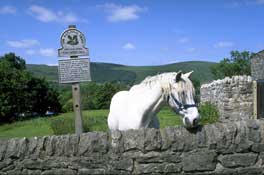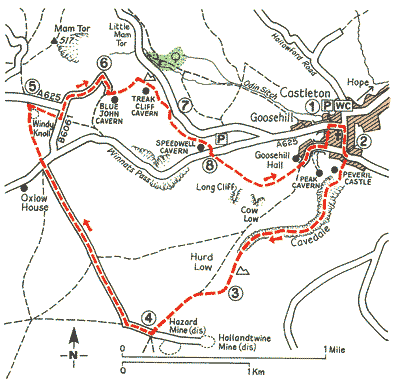Total Distance: 5 miles
Total ascent: 820 feet
Level of difficulty: Easy
Castles and Caverns
Castleton is where the limestone of the White Peak and the shales and gritstone of the Dark Peak collide.
Castleton is the last settlement before the Hope Valley narrows and
squeezes into the rocky ravine of Winnats. It's a bustling tourist town
with a history evident back to Norman times, and a geology that has been
responsible for many of its successes and most of its failures. At
Castleton the shales and gritstone of the Dark Peak and the limestone
plateaux of the White Peak meet. Here countless generations of miners
have dug their shafts and enlarged the natural caves which riddle the
bedrock in search of ore. Here too, they built an ambitious road that
eventually succumbed to the landslides of Mam Tor, 'the Shivering
Mountain'.
The castle keep is perched high upon an outcrop of limestone. It's one of the earliest stone-built castles in the country, built shortly after the Norman Conquest by William Peveril, William the Conqueror's illegitimate son.
The entrance to Cavedale is narrow and dramatic. One minute you're in the village square, the next you've turned the corner and entered an awesome limestone ravine. Geologists used to think Cavedale was a collapsed cavern, but current thinking places it as a valley carved by glaciers of the last Ice Age.

A little limestone path takes you through the ravine, climbing past cave entrances and over the tops of a wide system of subterranean passages, including those of the nearby Peak Cavern. The valley shallows and the next stretch of the journey is over high green fields enclosed by dry-stone walls. Mam Tor, the Shivering Mountain, dominates the view ahead and soon you look down on the crumbling tarmac of the ill-fated road, and the huge shale landslides that have plagued the valley for centuries.
The first Castleton cavern of the day is the Blue John Mine, high on the side of Mam Tor. It takes its name from the purple-blue fluospar, unique to Castleton. The floodlights of the chambers show off the old river galleries with crystalline waterfalls, and a fascinating array of stalagmites and stalactites.
Beyond the Blue John Mine a narrow path rakes across the steep limestone-studded slopes past Treak Cliff Cavern to the Speedwell Cavern, at the foot of the Winnats Pass. If you like boat trips, a visit to this cavern is a must. Here, lead miners excavated a level into the hill, through which they built a subterranean canal, 547yds (500m) long. This took them eleven years, but low yields and high costs forced the early closure of the mine. The fascinating boat trip takes you down the canal to a landing stage just short of the 'Bottomless Pit', named because the spoil thrown in by miners made no impression on its depth.
The last stretch takes you across the National Trust's Longcliffe Estate. Before retreating to Castleton, take one last look back up the valley, and across the limestone that was once a coral reef in a tropical lagoon.
The castle keep is perched high upon an outcrop of limestone. It's one of the earliest stone-built castles in the country, built shortly after the Norman Conquest by William Peveril, William the Conqueror's illegitimate son.
The entrance to Cavedale is narrow and dramatic. One minute you're in the village square, the next you've turned the corner and entered an awesome limestone ravine. Geologists used to think Cavedale was a collapsed cavern, but current thinking places it as a valley carved by glaciers of the last Ice Age.

A little limestone path takes you through the ravine, climbing past cave entrances and over the tops of a wide system of subterranean passages, including those of the nearby Peak Cavern. The valley shallows and the next stretch of the journey is over high green fields enclosed by dry-stone walls. Mam Tor, the Shivering Mountain, dominates the view ahead and soon you look down on the crumbling tarmac of the ill-fated road, and the huge shale landslides that have plagued the valley for centuries.
The first Castleton cavern of the day is the Blue John Mine, high on the side of Mam Tor. It takes its name from the purple-blue fluospar, unique to Castleton. The floodlights of the chambers show off the old river galleries with crystalline waterfalls, and a fascinating array of stalagmites and stalactites.
Beyond the Blue John Mine a narrow path rakes across the steep limestone-studded slopes past Treak Cliff Cavern to the Speedwell Cavern, at the foot of the Winnats Pass. If you like boat trips, a visit to this cavern is a must. Here, lead miners excavated a level into the hill, through which they built a subterranean canal, 547yds (500m) long. This took them eleven years, but low yields and high costs forced the early closure of the mine. The fascinating boat trip takes you down the canal to a landing stage just short of the 'Bottomless Pit', named because the spoil thrown in by miners made no impression on its depth.
The last stretch takes you across the National Trust's Longcliffe Estate. Before retreating to Castleton, take one last look back up the valley, and across the limestone that was once a coral reef in a tropical lagoon.


No comments:
Post a Comment